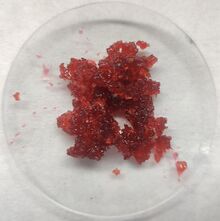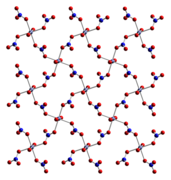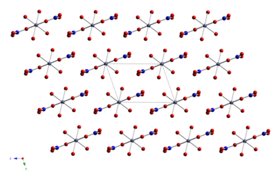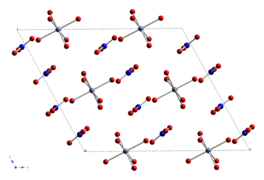Chemistry:Cobalt(II) nitrate

| |
| Names | |
|---|---|
| Other names
Cobaltous nitrate
Nitric acid, cobalt(2+) salt | |
| Identifiers | |
| |
3D model (JSmol)
|
|
| ChEBI | |
| ChemSpider | |
| EC Number |
|
PubChem CID
|
|
| RTECS number |
|
| UNII | |
| UN number | 1477 |
| |
| |
| Properties | |
| Co(NO3)2(H2O)6 | |
| Molar mass | 291.03 g/mol (hexahydrate) 182.943 g/mol (anhydrous) |
| Appearance | pale red powder (anhydrous) red crystalline (hexahydrate) |
| Odor | odorless |
| Density | 1.87 g/cm3 (hexahydrate) 2.49 g/cm3 (anhydrous) |
| Melting point | 100 °C (212 °F; 373 K) decomposes (anhydrous) 55 °C (hexahydrate) |
| Boiling point | 100 to 105 °C (212 to 221 °F; 373 to 378 K) decomposes (anhydrous)[citation needed] 74 °C, decomposes (hexahydrate) |
| anhydrous:[1] 84.03 g/100 mL (0 °C) 334.9 g/100 mL (90 °C) soluble (anhydrous) | |
| Solubility | soluble in alcohol, acetone, ethanol, ammonia (hexahydrate), methanol 2.1 g/100 mL |
| Structure | |
| monoclinic (hexahydrate) | |
| Hazards | |
| Safety data sheet | Cobalt (II) Nitrate MSDS |
| GHS pictograms |  
|
| GHS Signal word | Danger |
| H317, H334, H341, H350, H360, H410 | |
| P201, P202, P261, P272, P273, P280, P281, P285, P302+352, P304+341, P308+313, P321, P333+313, P342+311, P363, P391, P405, P501 | |
| NFPA 704 (fire diamond) | |
| Lethal dose or concentration (LD, LC): | |
LD50 (median dose)
|
434 mg/kg; rat, oral (anhydrous) 691 mg/kg; rat, oral (hexahydrate) |
| Related compounds | |
Other anions
|
Cobalt(II) sulfate Cobalt(II) chloride Cobalt oxalate |
Other cations
|
Iron(III) nitrate Nickel(II) nitrate |
Except where otherwise noted, data are given for materials in their standard state (at 25 °C [77 °F], 100 kPa). | |
| Infobox references | |
Cobalt nitrate is the inorganic compound with the formula Co(NO3)2.xH2O. It is cobalt(II)'s salt. The most common form is the hexahydrate Co(NO3)2·6H2O, which is a red-brown deliquescent salt that is soluble in water and other polar solvents.[2]
Composition and structures
As well as the anhydrous compound Co(NO3)2, several hydrates of cobalt(II) nitrate exist. These hydrates have the chemical formula Co(NO3)2·nH2O, where n = 0, 2, 4, 6.
Anhydrous cobalt(II) nitrate adopts a three-dimensional polymeric network structure, with each cobalt(II) atom approximately octahedrally coordinated by six oxygen atoms, each from a different nitrate ion. Each nitrate ion coordinates to three cobalts.[3] The dihydrate is a two-dimensional polymer, with nitrate bridges between Co(II) centres and hydrogen bonding holding the layers together.[4] The tetrahydrate consists of discrete, octahedral [(H2O)4Co(NO3)2] molecules. The hexahydrate is better described as hexaaquacobalt(II) nitrate, [Co(OH2)6][NO3]2, as it consists of discrete [Co(OH2)6]2+ and [NO3]− ions.[5] Above 55 °C, the hexahydrate converts to the trihydrate and at higher temperatures to the monohydrate.[2]
Uses and reactions
It is commonly reduced to metallic high purity cobalt.[2] It can be absorbed on to various catalyst supports for use in Fischer–Tropsch catalysis.[6] It is used in the preparation of dyes and inks.[7]
Cobalt(II) nitrate is a common starting material for the preparation of coordination complexes such as cobaloximes,[8] carbonatotetraamminecobalt(III),[9] and others.[10]
Production
The hexahydrate is prepared treating metallic cobalt or one of its oxides, hydroxides, or carbonate with nitric acid:
- Co + 4 HNO3 + 4 H2O → Co(H2O)6(NO3)2 + 2 NO2
- CoO + 2 HNO3 + 5 H2O → Co(H2O)6(NO3)2
- CoCO3 + 2 HNO3 + 5 H2O → Co(H2O)6(NO3)2 + CO2
References
- ↑ Perrys' Chem Eng Handbook, 7th Ed
- ↑ 2.0 2.1 2.2 John Dallas Donaldson, Detmar Beyersmann, "Cobalt and Cobalt Compounds" in Ullmann's Encyclopedia of Industrial Chemistry, Wiley-VCH, Weinheim, 2005. doi:10.1002/14356007.a07_281.pub2
- ↑ Tikhomirov, G. A.; Znamenkov, K. O.; Morozov, I. V.; Kemnitz, E.; Troyanov, S. I. (2002). "Anhydrous Nitrates and Nitrosonium Nitratometallates of Manganese and Cobalt, M(NO3)2, NO[Mn(NO3)3], and (NO)2[Co(NO3)4]: Synthesis and Crystal Structure". Z. anorg. allg. Chem. 628 (1): 269–273. doi:10.1002/1521-3749(200201)628:1<269::AID-ZAAC269>3.0.CO;2-P.
- ↑ Ribár, B.; Milinski, N.; Herak, R.; Krstanovič, I.; Djurič, S. (1976). "The Crystal Structure of Cobalt Nitrate Dihydrate, Co(NO3)2·2H2O". Zeitschrift für Kristallographie 144 (1–6): 133–138. doi:10.1524/zkri.1976.144.1-6.133. Bibcode: 1976ZK....144..133R.
- ↑ Prelesnik, P. V.; Gabela, F.; Ribar, B.; Krstanovic, I. (1973). "Hexaaquacobalt(II) nitrate". Cryst. Struct. Commun. 2 (4): 581–583.
- ↑ Ernst B, Libs S, Chaumette P, Kiennemann A. Appl. Catal. A 186 (1-2): 145-168 1999
- ↑ Lewis, Richard J., Sr. (2002). Hawley's Condensed Chemical Dictionary (14th Edition). John Wiley & Sons. http://www.knovel.com/knovel2/Toc.jsp?BookID=704&VerticalID=0
- ↑ Schrauzer, G. N. (1968). Bis(Dimethylglyoximato)Cobalt Complexes: ("Cobaloximes"). Inorganic Syntheses. pp. 61–70. doi:10.1002/9780470132425.ch12. ISBN 9780470132425.
- ↑ Schlessinger, G. (1960). "Carbonatotetramminecobalt(III) Nitrate". Inorganic Syntheses 6: 173–175. doi:10.1002/9780470132371.ch55. ISBN 9780470132371.
- ↑ Hargens, Robert D.; Min, Woonza; Henney, Robert C. (1973). "Bis(ethylenediamine)sulfito Complexes of Cobalt(III)". Inorganic Syntheses. Inorganic Syntheses. pp. 77–81. doi:10.1002/9780470132456.ch15. ISBN 9780470132456.
| HNO3 | He | ||||||||||||||||
| LiNO3 | Be(NO3)2 | B(NO3)−4 | C | NO−3, NH4NO3 |
O | FNO3 | Ne | ||||||||||
| NaNO3 | Mg(NO3)2 | Al(NO3)3 | Si | P | S | ClONO2 | Ar | ||||||||||
| KNO3 | Ca(NO3)2 | Sc(NO3)3 | Ti(NO3)4 | VO(NO3)3 | Cr(NO3)3 | Mn(NO3)2 | Fe(NO3)3, Fe(NO3)2 |
Co(NO3)2, Co(NO3)3 |
Ni(NO3)2 | Cu(NO3)2 | Zn(NO3)2 | Ga(NO3)3 | Ge | As | Se | Br | Kr |
| RbNO3 | Sr(NO3)2 | Y(NO3)3 | Zr(NO3)4 | Nb | Mo | Tc | Ru | Rh | Pd(NO3)2 | AgNO3 | Cd(NO3)2 | In | Sn | Sb(NO3)3 | Te | I | Xe(NO3)2 |
| CsNO3 | Ba(NO3)2 | Hf | Ta | W | Re | Os | Ir | Pt | Au | Hg2(NO3)2, Hg(NO3)2 |
Tl(NO3)3, TlNO3 |
Pb(NO3)2 | Bi(NO3)3 BiO(NO3) |
Po | At | Rn | |
| FrNO3 | Ra(NO3)2 | Rf | Db | Sg | Bh | Hs | Mt | Ds | Rg | Cn | Nh | Fl | Mc | Lv | Ts | Og | |
| ↓ | |||||||||||||||||
| La(NO3)3 | Ce(NO3)3, Ce(NO3)4 |
Pr | Nd(NO3)3 | Pm | Sm | Eu(NO3)3 | Gd(NO3)3 | Tb(NO3)3 | Dy | Ho | Er | Tm | Yb | Lu | |||
| Ac(NO3)3 | Th(NO3)4 | Pa | UO2(NO3)2 | Np | Pu | Am | Cm | Bk | Cf | Es | Fm | Md | No | Lr | |||
 |






